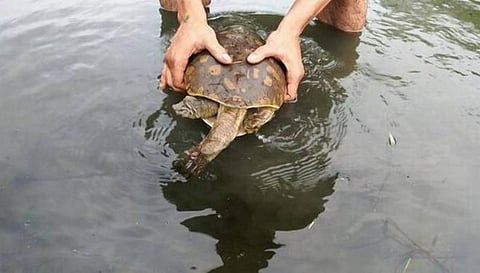
- Home
- Live Blog
- Breaking News
- Top Headlines
- Cities
- NE News
- Sentinel Media
- Sports
- Education
- Jobs

A CORRESPONDENT
NUMALIGARH: Assam’s Brahmaputra and Barak valleys are very rich in terms of freshwater turtle and tortoise diversity. This area is one of the top 25 Priority Turtle Conservation areas of the world. But due to increasing anthropogenic pressure on their habitat, human consumption and illegal trading, turtles are slowly vanishing from the wild habitats. These turtles are also victims of various religious traditional beliefs and superstitions and many of them end up in the congested unnatural ponds of religious institutes.
Almost all the shrines of Assam have ponds in their premises. Most of these ponds house a wide variety of turtle species. There are more than 25 temple turtle tanks throughout Assam. Since time immemorial these tanks have been serving as the storehouses of some of the rarest species of freshwater turtles and a few of these reptiles are also breeding there.
Dr. Rajeev Basumatary, president of Tuskers Task Force (TTF) and advisor and collaborator of TSA (Turtle Survival Alliance), NE region, who is also an Assistant Professor in the Department of Zoology, DR College, expressed grief over the pathetic condition of temple turtles in Assam. Recently, he visited the historic Aathkhelia Naamghar in Golaghat and witnessed that the pond turtles were living in a very pathetic condition. Concrete walls were seen built around the pond so that despite the turtles remaining in the pond, the surroundings there prevent these turtles from breeding and increasing their population.
Talking to this correspondent, Dr Basumatary said, “Due to lack of knowledge and awareness, most of these temple tanks in Assam have been made concrete. Being cold-blooded animals, reptiles need to sun bath to maintain their body temperature and metabolism. Depriving them from basking habitat or facility leads to certain lethal health issues, like shell rot, fungal growth on shell, skin rot, parasite infestation on skin and gas problem in the gut. Moreover, due to insufficient sun basking, their shell and bone formation is incomplete.”
“Natural ponds maintain a healthy ecosystem, and they have their own process to clean the water. But when we eliminate the natural elements like aquatic plants, floating logs and insects in the name of cleaning, the ecological balance in the ponds is disturbed and results in chain of destruction of species. You cannot maintain only turtle or fish in a pond; you need other elements of nature also. Moreover, throwing of biscuits or puffed rice for feeding turtles also pollute the water by altering its PH, alkalinity, dissolved oxygen, turbidity and microbial growth,” he added.
“Turtles are aquatic but tortoises are terrestrial and cannot live in water. But there are incidences of releasing tortoises also in the temple ponds. So awareness is lacking among the common masses as well as temple authorities which is harming our biodiversity,” he further said.
Dr Basumatary added, “Construction of concrete wall to keep the turtles in the pond is preventing these turtles from breeding and increasing their population. Therefore, this act cannot be considered as conservation. Rather such activities are wiping out our turtle diversity. However, temple ponds are regularly receiving turtles. But due to lack of proper management they are dying there. Therefore, I think that the temple management authorities, the Assam Forest Department and the district administration should enforce some strict regulations for the sake of those turtles. Besides, turtles are scheduled animals under the Indian Wildlife Protection Act, 1972.”
He also said that as remedial measures some simple interventions in the turtle ponds could make their life better. First, there should be a bank in the pond, if the bank has already been made concrete then a slope bridge can be constructed so that they can access the bank for egg laying or basking. Second, maintaining the pond in natural condition as much as possible with local aquatic plants and fishes which will help in cleaning the water. Third, some dead floating logs should be kept for providing a platform so that turtles can use these for sun-basking. Fourth, from overcrowded ponds a few big individuals as well as turtle babies should be released back to rivers or beels periodically so that natural population is maintained. This is being practised by the concerned authorities at two temples of Assam — the Hoigrib Madhab Temple of Hajo and the Nagaon Amulaputty Sivathaan Temple. (IANS)